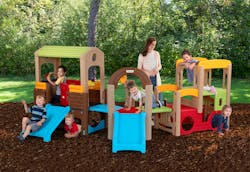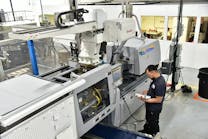Looking back on the unprecedented year that was 2020, Jim Miller said it wasn’t an unalloyed good or bad year for his rotomolding company.
“I’d say it was mixed, because I think the sales and the demand is where we were expecting, but we just didn’t have the workforce throughout part of the year to make what we needed,” he said.
Miller is president and CFO of Simplay3, a Streetsboro, Ohio, manufacturer of rotomolded toys and home and garden products. Although it is a young company, it comes from a distinguished pedigree: Simplay3 is the third of three U.S.-based companies — all rotomolders — started over the years by Tom Murdough. He began by founding Little Tikes in 1969, Step2 in 1991 and Simplay3 in 2016. His long record of success and innovation led to Murdough’s induction into the Toy Industry Hall of Fame in 2020.
“I’ve been with Tom now 29 years,” said Miller, who first began working with Murdough at Step2. “He’s a great leader, he’s taught many of us and mentored many of us. So, we’re just trying to create another company that’s done as well as the last two.”
In March 2020, the state of Ohio enacted a stay-at-home order that extended to non-essential businesses. One positive for Simplay3 was that it was deemed an essential business, Miller said. However, some of its employees were rattled by the threat of COVID-19.
“We gave the option to all of our workers — if they didn’t feel comfortable with it, they could stay home,” Miller said. “And many of them did. So, our production force was greatly reduced for about eight weeks.”
And at about the same time, parents across the nation found themselves working from home, while also needing to keep their children occupied.
Marshall Murdough, manager of Ecommerce at Simplay3 and son of founder and CEO Tom Murdough, said that in March and April, the company saw an enormous spike in orders. Simplay3 has a range of products that allow for imaginative play, like a double-sided track table for toy trains and cars, and active play, like its Young Explorers Adventure Climber, which has steps, platforms and a slide.
“Most of our products happen to be indoor and outdoor, so we’re able to play that card pretty well,” Murdough said. “That climber, for example, is narrow enough to go through a doorway, and can be [washed off and] brought inside pretty easily,” he said.
Pandemic boosts demand
Miller said that as employees returned to work at Simplay3, the company implemented social distancing and other measures to keep them safe, but that spike in orders kept them scrambling.
“With sales going up, production going down, we kind of got squeezed. We really almost emptied out our warehouse,” he said.
Murdough said that to handle demand, decisions had to be made about what products to focus on. “We had to prioritize products that we could count on, and as a result there were a lot of products that may have been … put to the side. And I give our plant manager all the credit in the world because, being able to sustain what we did in those summer months was real challenging. … He did a tremendous job in juggling and balancing to get to where we are now.”
The challenges weren’t just within the walls of Simplay3. With more people staying at home across the nation and the boost in online shopping, demand for delivery services quickly went through the roof. Murdough said that by August, the company’s carriers told them they had already hit levels of demand that were normally only seen in December.
“They were telling us then to really talk to your customers and warn them that this is not going to be like last year or any previous years, we’re gonna have to really get the word out to shop earlier,” he said. “If they want something guaranteed by Christmas, they’ve got to really get that order in before Thanksgiving.”
He pointed to retailers’ response to the season, where instead of condensing holiday sales into the typical Black Friday/Cyber Monday time frame, they began unveiling sales in October and early November, to relieve some of the pressure.
“Somebody made the reference e-commerce evolved in six months what would typically take 10 years to evolve because everybody was just accelerating towards making this happen for customers,” Murdough said. “As a result, you’re seeing the major networks — FedEx, UPS, USPS — they're overloaded and working hard to get the product to the customer.”
Growth follows challenges
Despite the hurdles that sprang up early in 2020, the year also sparked a lot of growth at Simplay3. Miller said the company had long-term plans to add employees, machines and warehouse space, but the timeline was over the next several years. The pandemic moved all of those plans forward.
Simplay3 began last year with between 60 and 70 employees, with plans to not quite double that number over the following two to three years. Miller said that the company ended 2020 with more than 80 employees.
Since it opened in 2016, Simplay3 had shared its building with one other company. When that tenant moved out, the company was able to begin reorganizing its departments, and soon its R&D team will be able to move in, putting the entire company under one roof. Simplay3 also started construction on a 60,000-square-foot addition. When completed, the total building footprint will be 145,000 square feet, with more than double the manufacturing and warehouse space at 130,000 square feet. That construction is expected to be completed in March or April.
“I don’t think we would have added on 60,000 square feet if we didn’t believe we were going to be able to fill the plant,” Murdough said. “… I think we’ll probably see it bursting at the seams a lot sooner than we would typically expect with the kind of activity we’re seeing and those people warming up to Simplay3.”
Miller said his company uses a mix of Rotoline and Ferry machines, and the machines have a ring or spider with diameters ranging from about 6.2 feet to 9.2 feet. He said models include the 190 Ferry, 200 Ferry, 2.0 Rotoline and a 2.6 Rotoline. The building expansion will make room for more machines, which Simplay3 will continue to add from both manufacturers.
Unique traits of rotomolding
While injection molding is a much more widespread manufacturing method — and a process that lends itself to automation — Simplay3 sees advantages to rotomolding.
“You know, it’s a lot more labor intensive than your typical process,” Murdough said, “and as a result you have … products that have a double-wall construction, so it’s gonna last you a long time.”
The blessing of durability also poses a bit of a curse, Miller said. “There’s a double-edged sword to our products being so good and they last so long — they don’t wear out and they typically get passed on either to neighbors or family members. They outgrow them and they give them to other family members … but people do like to buy new products for their kids and we, I think, come out with good new designs.”
Machine operators have a lot of hands-on time in the process, as they put resin powder into the molds on each of a machine’s four arms and then send them to work their way through the oven, cooling stations and then back to the operator. The operator opens the molds, removes the still-warm finished parts and inspects them. Some products are pulled from the mold ready to box; for others, the operator may attach additional parts like wheels, or put multiple components into the box, then refill the molds with resin powder and send that arm through the cycle again.
“And the neat thing about rotational molding is … within 20 minutes, a half hour it goes from resin powder [to a finished product] into the box,” Miller said. “There is really no work-in-process inventory.”
Boxed products are gathered at the machine’s side into bundles that are then moved directly to the warehouse.
Evolution of the business
In some ways, Simplay3 is at a stage of growth its leaders have seen before at the other companies Tom Murdough founded. But many things have changed about the business environment it inhabits.
Marshall Murdough said that when his father started Step2 after leaving Little Tikes, “He was only two years or three years retired, so the relationships he had built, largely brick-and-mortar buyers, those relationships stayed with him.” But when he started Simplay3 in 2016, “He was out [retired] about 10 years and the landscape changed dramatically. There was no longer a bricks-and-mortar focus, it was really more of a hybrid: Online, e-commerce and bricks and mortar.”
Miller said the relationship between manufacturers and retailers used to be paramount. “I’m dating myself here but, when I started at Step2, the business was all retail.” Because of the influence retailers had over the manufacturers, retailers would sometimes ask their suppliers to develop toys to compete with rivals’ products, or to help them meet certain metrics. “So, then it tied your hands a little bit to make something that maybe wasn’t the best. Although with Tom Murdough and our team there, we came up with products and went to the retailers and said ‘Hey, give this one a try.’ And he had such great relationships with them … that they would try our product and it would do well.”
Retailers’ influence could sometimes be heavy-handed. Miller said, “Pre-internet, Toys ‘R’ Us in our case at Step2 or Walmart would dictate what kind of level of production you had … And they would order — I’ll throw out numbers — 50,000 of them, 100,000 of them. And if they didn’t start moving very quickly, they’d start trimming those orders.”
“Meanwhile, as a manufacturer,” he said, “you’re starting to order supplies to fulfill those orders, and sometimes even have them in your warehouse, and now you’re kind of — I won’t say stuck, but now you’ve got to find a different avenue of selling them or reduce the price.”
“But … that’s how it was done in the old days,” Miller said. “Well now, there are fewer retailers out there buying products like that — Toys ‘R’ Us goes away and … I want to say they provided like $6 billion worth of children’s products domestically and $8 billion worldwide. So, when they go away, who picks up the difference?”
Retailers would also impose their sales calendar on manufacturers. “Like outdoor children’s products,” Miller said. “They’d take them up through early June and then stop in July because they were switching to a new season of products, and then they start discounting everything they had. Or [they] came back to you as the manufacturer for some participation in that to continue working with them.”
While there is uncertainty caused by the decreased role of retailers, it also gives new freedom to Simplay3. “Well, now what’s changed is we’re dealing direct with the consumer, which is kind of neat — we love that because we feel we can make products the consumer wants,” Miller said. “Now we’ve got a couple years of history of seeing how products sell, so we can kind of gauge what we need to make in what season and then layer into that any retail orders we have. So, it’s a different business than it used to be … in product distribution.”
“When we were at Step2, Tom always liked to leave the market a little bit short,” Miller said. “I mean, we like to run our warehouse empty at the end of the year, we keep them coming back for more, and not oversaturate them. That was always the philosophy Tom had, and especially when you’re a growing company, it kind of worked out that way.”
And where retailers had once made many of the advertising decisions that manufacturers had to abide by, Simplay3 now handles those and other tasks in-house. The company’s social media team shoots videos of how the products are used and photos for product packaging as well as for use on the website, Instagram, Facebook ads, etc.
“We have to now create all that,” Miller said. “But no one better than us, because we know the product.”
Murdough said the social media team has worked hard to help establish the brand online. “Probably the most important aspect of e-commerce and a brand is establishing a trust with your consumer,” he said.
“This has really happened the reverse [of a traditional retail model] where the e-commerce has established our company, our products, and the retailers are seeing the success that we’ve had, reading reviews, reading various consumer forums about our products, seeing the awards we’ve won,” Murdough said.
He added that the internet has been a game changer, not only for sales, but also for spreading product awareness. “Used to be you go to a store, you buy a product, and then you talk about it. But people watch the video and they share it with their friends before, so there’s a lot of pre-activity versus word of mouth after,” he said.
The vital role of talent
Miller emphasized the importance that a talented workforce has played in the company.
“We’ve got a great group of employees; many have come from Step2 and Little Tikes,” Miller said. “Up and down the company, great people that are very experienced.”
Murdough echoed Miller’s sentiment, pointing out the talent in manufacturing, shipping and receiving as well as the company’s design team. “There’s no way we could jump out of the gates as quickly without having the design team that we’ve got to design the products that we have, or the manufacturing knowledge and capability — there’s no way we could have done that if he [Tom Murdough] doesn’t have those people that he’s worked with in the past.”
As an example of the many competing priorities the design team keeps in balance, Murdough pointed again to the Young Explorers Adventure Climber, which came out in 2019. The product is large, and yet the designer found a way to make it fit inside a box that is just smaller than what carriers deem oversize — avoiding a large increase in delivery costs. That product is now joined by two new climbing sets that were introduced in the fall of 2020 — the Discovery Playhouse and Activity Climber. Each is a standalone unit, but they’ve been designed as part of a modular system, so that any two — or all three — can be assembled together into a variety of configurations.
Looking at the year ahead
Speaking in late December, Miller sounded an optimistic note for the new year.
“I expect 2021 could be a strong year for us,” Miller said. “I think I feel better than I did at the beginning of the year [2020] because of the product strength we have and the new products we’ve developed.”
Miller spoke about how the company has grown over the past four years and noted the milestones it has passed. Its portfolio of products has increased; its brand is gaining recognition and stability; it has added tools and employees; and it is in the process of increasing its building’s size and its fleet of rotomolding machines.
“I think every year we’re more established, and I think as we go into this coming year, I think it’s going to be an important year,” he said. “Every year I feel better and better about us becoming a major player in this area.”
David Tillett, associate editor
David Tillett | Associate Editor
Associate Editor David Tillett writes and edits for Plastics Machinery & Manufacturing, Plastics Recycling and The Journal of Blow Molding. He covers new products, industry news, patents and consumer and business equipment. He has more than 20 years of experience in daily newspaper, online and magazine journalism.







